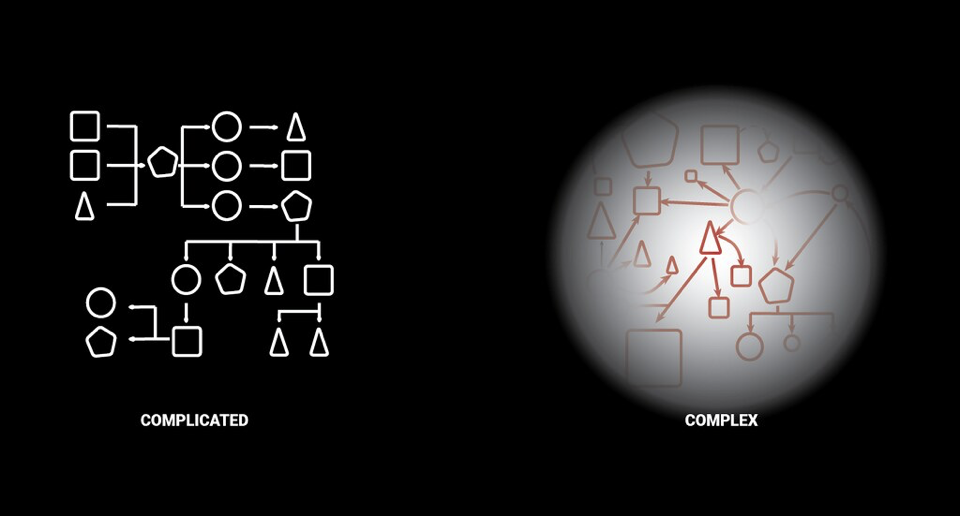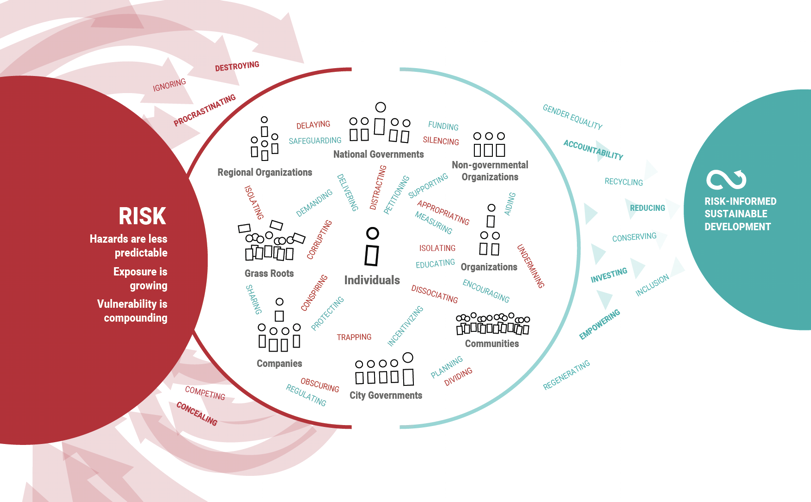What is the difference between complicated and complex systems... and why is it important in understanding the systemic nature of risk?
This is the third in a series of eight articles co-authored by Marc Gordon (@Marc4D_risk), UNDRR and Scott Williams (@Scott42195), building off the chapter on ‘Systemic Risk, the Sendai Framework and the 2030 Agenda’ included in the Global Assessment Report on Disaster Risk Reduction 2019. These articles explore the systemic nature of risk made visible by the COVID-19 global pandemic, what needs to change and how we can make the paradigm shift from managing disasters to managing risks.
We need to clarify the distinction between a ‘complicated’ and a ‘complex’ system. A complicated system can be (dis-)assembled and understood as the sum of its parts. Just as a car is assembled from thousands of well-understood parts, which when combined allow for simpler and safer driving. Multi-hazard risk models allow for the aggregation of risks into well-behaved, manageable or insurable risk products.
By contrast, a complex system exhibits emergent properties that arise from interactions among its constituent parts in which relational information is of critical importance to integrate the complex system. Understanding a complex system is not enough to know the parts. It is necessary to understand the dynamic nature of the relationships between each of the parts. In a complex system, it is impossible to know all the parts at any point in time. The human body, a city traffic system, or a national public health system are examples of complex systems.

The priorities for action of the Sendai Framework spur a new understanding of risk. They reinforce the obvious value of discerning the true nature and behaviour of systems, rather than thinking of systems as a collection of discrete elements. Risk management models, as well as economic models and related policymaking, have tended to treat systems as complicated. With this method, simplified stylized models are often applied to single entities or particular channels of interaction to first define and then label the risk phenomena. Methods are then negotiated by stakeholders to quantify or otherwise objectively reflect, the risk in question and then to generalize it again to make policy choices.
Most prevailing risk management tools assume that underlying systems are 'complicated’. Rather than 'complex'. In fact, these tools are often designed to suppress complexity and uncertainty. This approach is out-dated, and potentially very harmful – not least in the context of the developing COVID-19 pandemic. And is likely to produce results that fail to capture the rising complexity and need to navigate the full topography of risks.
Risk and uncertainty are measures of deviation from ‘normal’. Risk is the part of the unexpected quantified by the calculation of probabilities. Uncertainty is the other part of the unexpected. Where information may exist, it may not be available, not recognized as relevant, or unknowable. In a complex system, which is inherently unpredictable, probabilities for uncertainties cannot be reliably measured in a manner currently acceptable to the global risk management community, including governments. Converting uncertainty into acceptable risk quantities that essentially emanate from the dynamic, relational nature of complex system behaviour is currently very difficult, even impossible. Some uncertainties in any complex system will always remain unmeasurable.
Understanding sensitivities to change and system reverberations is far more important and more challenging in the context of complex systems. Particularly when dealing with very large human, economic and ecological loss and damage across the planet – as is the case with the COVID-19 pandemic. Simulations of such systems show that very small changes can produce almost unnoticeable but still identifiable initial ripples. These are then amplified by non-linear effects and associated path dependencies, causing changes that lead to significant, and potentially irreversible, consequences. This is what the world is experiencing now with the highly infectious COVID-19 outbreak. Country after country impose lockdowns and strict restrictions on human interactions, as individuals do not fully appreciate that a single infected (and possibly asymptomatic) person can provoke tens of thousands of cases of infection within weeks.

Risk is everyone’s business. Almost everyone across the world is starting to understand this, with physical distancing fast becoming the global norm. We must now review how our relationship with behaviour and choice transfers to individual and collective accountability for risk creation and amplification, or for risk reduction. This understanding must translate into action.
Increasing complexity in a networked world of complex, tightly coupled human systems (economic-political-technical-infrastructure-health) within nature can create instability and move beyond control. It may not be possible to understand this ahead of time (that is, ex ante). This inability to understand and manage systemic risk is an important challenge for current risk assessments, including in the context of the response to the COVID-19 pandemic, the wider context of the Sendai Framework and the achievement of the 2030 Agenda on Sustainable Development.
To allow humankind to embark on a development trajectory which is, at the very least, manageable, and at best sustainable and regenerative, consistent with the 2030 Agenda on Sustainable Development, a fundamental rethink and redesign of how to deal with systemic risk is essential; starting with a shift in mindset from ‘complicated’ to ‘complex’.
We must improve our understanding of the interdependencies between system components, including precursor signals and anomalies, systems reverberations, feedback loops and sensitivities to change. Ultimately, the choices made right now in respect of risk and resilience to favour sustaining human health in the face of the COVID-19 pandemic will determine progress towards the goals of the 2030 Agenda and beyond.
The next article in this series will explore some of the recent efforts to better understand the fundamental characteristics of systemic risks and the implications for policy and investment decision making at all scales.